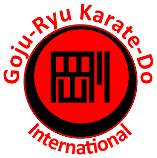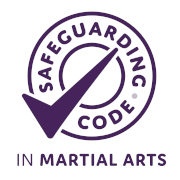Karateka Login
- Gary Brandon
(Birmingham Welfare Officer)
gb@carisbrookeboston.com
Mobile: (07956) 510-093 - Matthew Taylor
(GKI Welfare Officer)
matt.sensei@twyfordkarate.club
Tel: (0118) 9706-943
Mobile: (07766) 684-254 - Carly Barrett-Greening
(GKI Supporting Contact)
waveconnections@outlook.com
Mobile: (07850) 732-303
News
-
The GKI Winter Gasshuku 2024Monday, 11th November, 2024The GKI Winter Gasshuku was hosted in Birmingham and was very well attended with over 100 students from Portugal, Spain, Belgium, Sweden and the UK. Sensei James Rousseau, Sensei
-
The GKI Winter Gasshuku 2022Saturday, 26th November, 2022The GKI's winter gasshuku was held last weekend and it was very well attended not only by the UK contingent but also Portugal and Sweden put in a good showing too. Both Tristan
Kata
Goju-ryu has 12 core kata in its standard curriculum: gekisai (dai ichi & dai ni), saifa, seiyunchin, seisan, saipai, shisochin, sanseiru, kururunfa, sanchin, tensho, and suparenpai. Students in most schools are required to know all of these kata before reaching sandan.
Morio Higaonna writes that "Karate begins and ends with kata. Kata is the essence and foundation of karate and it represents the accumulation of more than 1000 years of knowledge. Formed by numerous masters throughout the ages through dedicated training and research, the kata are like a map to guide us, and as such should never be changed or tampered with."
Almost all of the kata have a corresponding bunkai oyo, a prearranged two-person fighting drill. These drills help the student to understand the applications of the kata, establish proper rhythm/flow, to practice constant attack/defense, and to safely practice dangerous moves on a partner.
Kihongata
Kihongata means a "kata of basics." In Goju-ryu, sanchin kata is the foundation to all other Goju kata because it teaches basic movements, basic techniques, power generation and breathing techniques from qigong. It is also the foundation of body conditioning. The more the karateka practices this kata, the more his Heishugata will change. First variation of Sanchin-kata (sanchin kata dai-ichi) serves as Kihongata. See more on Sanchin kata below.
Gekisai
Gekisai means "attack and destroy". These kata were created around 1940 by Chojun Miyagi and Nagamine Shoshin as beginners' kata, to introduce the basic forms of karate (kihon) to middle school students in Okinawa, to help bring about the standardization of karate, and to teach a basic set of techniques for self-defense. Gekisai kata were strongly influenced by the Shuri-te techniques that Miyagi learned from Anko Itosu.
Students first learn gekisai dai ichi and then gekisai dai ni. The main difference between dai ichi and dai ni is that dai ni introduces open handed techniques and new stances.It is in gekesai dai ni that students are introduced to the neko ashi dachi stance, and to the wheel block(mawashe uke).
Saifa
Saifa means "smash and tear".Saifa has its origins in China, and was brought to Okinawa by Higashionna. It contains quick whipping motions, hammerfists, and back fist strikes; it particularly emphasizes moving off-line from an opponent's main force, while simultaneously closing distance and exploding through them. This is usually the first advanced Goju-ryu kata the students learn in most goju kaiha, after gekisai dai ichi and gekisai dai ni.
Sanchin
Sanchin means "three battles". This kata is a sort of moving meditation, whose purpose is to unify the mind, body and spirit. The techniques are performed very slowly so that the student masters precise movements, breathing, stance/posture, internal strength, and stability of both mind and body.
Sanchin is the foundation for all other kata, and is generally considered to be the most important kata to master. When new students came to Miyagi, he would often train them for three to five years before introducing them to sanchin. He would make them train very hard, and many of them quit before learning sanchin. Those that remained would focus almost exclusively on sanchin for two to three years. Miyagi's sanchin training was very harsh, and students would often leave practice with bruises from him checking their stance.
Tensho
Tensho means "revolving hands".Like sanchin, tensho is a form of moving meditation; tensho combines hard dynamic tension with soft flowing hand movements, and concentrates strength in the tanden. Tensho can be considered the ju (soft) counterpart of the sanchin's go (hard) style.
Kaishugata
Kaishugata means a "kata with open hands." This is more advanced than Heishugata. Kaishugata serves as a "combat application reference" kata and is open to vast interpretation (Bunkai) of it's movements purpose (hence, "open hands").
- Seiunchin - (attack, conquer, suppress; also referred to as "to control and pull into battle"): Seiunchin kata demonstrates the use of techniques to unbalance, throw and grapple, contains close-quartered striking, sweeps, take-downs and throws.
- Shisochin - ("to destroy in four directions" or "fight in four directions"): It integrates powerful linear attacks (shotei zuki) and circular movements and blocks. It was the favorite kata of the late Miyagi.
- Sanseiru - (36 Hands): The kata teaches how to move around the opponent in close quarters fights, and emphasizes the destruction of the opponent's mobility by means of kanzetsu geri.
- Seipai - (18 Hands): Seipai incorporates both the four directional movements and 45 degree angular attacks and implements techniques for both long distance and close quarter combat. This was a Seikichi Toguchi's specialty kata.
- Kururunfa - (holding on long and striking suddenly): Its techniques are based on the Chinese Praying Mantis style. It was Ei'ichi Miyazato's specialty kata.
- Seisan - (13 Hands): Seisan is thought to be one of the oldest kata that is widely practiced among other Naha-te schools. Other ryuha also practice this kata or other versions of it.
- Suparimpei - (108 Hands): Also known as Pechurin, it is the most advanced Goju-ryu kata. Initially it had three levels to master (Go, Chu, and Jo), later Miyagi left only one, the highest, "Jo" level. This was a Meitoku Yagi's, Masanobu Shinjo, and Morio Higaonna's specialty kata.


